
Trillium is a genus of about fifty flowering plant species in the family Melanthiaceae. Trillium species are native to temperate regions of North America and Asia, with the greatest diversity of species found in the southern Appalachian Mountains in the southeastern United States.

Boraginaceae, the borage or forget-me-notfamily, includes about 2,000 species of shrubs, trees, and herbs in 146 to 154 genera with a worldwide distribution.
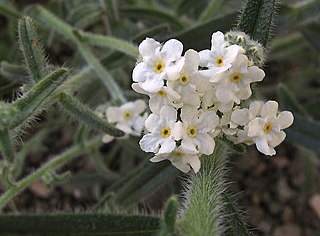
Cryptantha is a genus of flowering plants in the borage family, Boraginaceae. They are known commonly as cat's eyes and popcorn flowers. They are distributed throughout western North America and western South America, but they are absent from the regions in between.
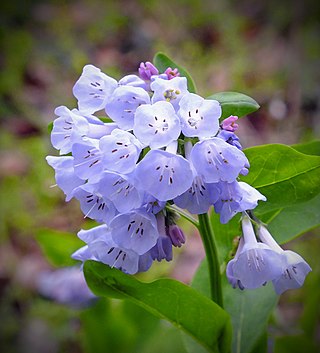
Mertensia is a genus of flowering plants in the family Boraginaceae. They are perennial herbaceous plants with blue or sometimes white flowers that open from pink-tinged buds. Such a change in flower color is common in Boraginaceae and is caused by an increase of pH in the flower tissue. Mertensia is one of several plants that are commonly called "bluebell". In spite of their common name, the flowers are usually salverform (trumpet-shaped) rather than campanulate (bell-shaped).

Triadenum, known as marsh St. John's worts, is a small genus of flowering plants in the family Hypericaceae. The genus is characterized by opposite, blunt-tipped leaves and pink flowers with 9 stamens. They are distributed in North America and eastern Asia.
Hoplestigma is a genus of flowering plants in the family Boraginaceae, although this is disputed, and it has been placed in its own family Hoplestigmataceae. Its two species are native to Cameroon, Gabon, Ivory Coast and Liberia in western tropical Africa.

Johnstonella angustifolia is a species of wildflower in the borage family known by several common names, including Panamint catseye and bristlelobe cryptantha. This plant is native to northern Mexico and the southwestern United States from California to Texas, where it grows in desert scrub and woodland.
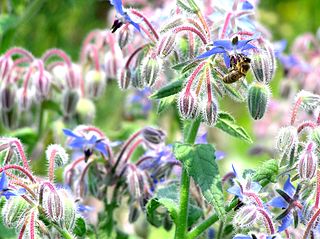
Boraginoideae is a subfamily of the plant family Boraginaceae s.s, with about 42 genera. That family is defined in a much broader sense in the Angiosperm Phylogeny Group (APG) system of classification for flowering plants. The APG has not specified any subfamilial structure within Boraginaceae s.l.

Greeneocharis circumscissa is a species of flowering plant in the borage family, known by the common name cushion cryptantha. It is native to western North America from Washington to Baja California to Colorado and it is also found in Argentina. It grows in sandy or gravelly types of habitat, from mountains to desert, below 9,500 m (31,200 ft) above sea level.
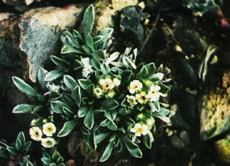
Oreocarya roosiorum is a species of flowering plant in the family Boraginaceae known by the common name bristlecone cryptantha.

Vanda christensoniana is a species of orchid endemic to Vietnam. The specific epithet christensoniana honours the botanist and taxonomist Eric Christenson.

Codon is a small genus of plants from South Africa in the family Codonaceae in the order Boraginales. The genus Codon comprises two species.
Oreocarya nubigena, synonym Cryptantha nubigena, is a perennial plant in the borage family (Boraginaceae), native to western North America. It may be called the Sierra cryptantha and Sierra oreocarya.
Johnstonella is a genus of flowering plants belonging to the family Boraginaceae.

Huynhia is a genus of flowering plants belonging to the family Boraginaceae, from Asia.
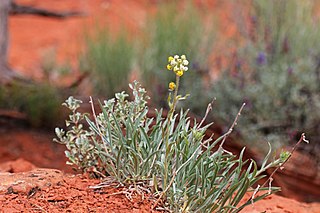
Oreocarya is a genus of flowering plants in the family Boraginaceae. There are about 63 species and its native range extends from western and central Canada, through western United States to north Mexico. It is part of subtribe of Amsinckiinae.

Greeneocharis is a genus of flowering plants in the family Boraginaceae. There are two species, and it has a disjunct distribution in the western United States and northwestern Mexico in North America and western Argentina in southern South America. It is part of subtribe of Amsinckiinae.
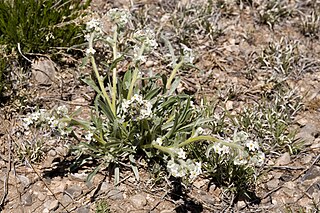
Oreocarya suffruticosa is a species of flowering plant in the family Boraginaceae, native to the west and central United States and to northern Mexico. It was first described by John Torrey in 1827 as Myosotis suffruticosa and transferred to Oreocarya by Edward Lee Greene in 1887. Varieties of Oreocarya suffruticosa have previously been placed within several species of Cryptantha, including Cryptantha cinerea, Cryptantha jamesii and Cryptantha pustulosa.

Oreocarya virgata, the miner's candle, is a species of flowering plant in the family Boraginaceae, native to the U.S. states of Wyoming and Colorado. It is a biennial herb reaching 0.9 m (3 ft), with white flowers.
















